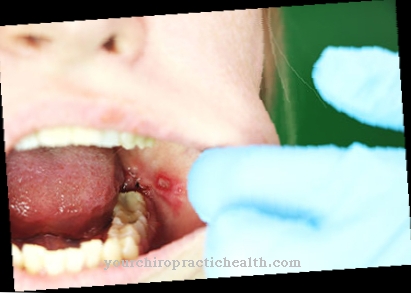Lung cancer or Bronchial carcinoma is a life-threatening and serious cancer. Mainly smokers get sick from this tumor. The first signs of lung cancer are shortness of breath, severe coughing and chest pain.
What is lung cancer?

Lung cancer or. Bronchial carcinoma is a malignant cancer of the lungs. Above all, this leads to an uncontrolled and degenerate proliferation of cells in the bronchi or airways. These then destroy the healthy tissue in the course of the process, which in the end often leads to the death of the person concerned.
Lung cancer can be divided into two medical forms: 1. Small-cell bronchial carcinoma and non-small-cell bronchial carcinoma. Non-small-cell lung cancer usually develops locally in the lungs and less often forms metastases.
Therefore, the chance of a cure is significantly higher here than with small cell lung cancer. Non-small cell lung cancer can, in turn, be differentiated into squamous cell carcinoma, adenocarcinoma and large cell lung cancer.
Although small cell lung cancers are rarer, their effects on humans are far more dangerous.They are very aggressive and grow very quickly. They also metastasize early on. Lung cancer is very common in Germany. Almost every third tumor disease is bronchial carcinoma. However, those affected are mostly older than 60 years. On average, men are twice as likely to develop lung cancer as women.
causes
The main causes of Lung cancer are smoking and the inhalation of carcinogenic substances, vapors and gases in professional and everyday life. Smoking is the biggest cause of lung cancer at around 90%. When smoking, hundreds of carcinogenic substances are inhaled, so that a regular smoker has a 40 times higher chance of developing lung cancer. But passive smoking also poses an enormous risk and should by no means be underestimated.
The second most common are carcinogenic substances from the environment, from professional life and from everyday life. Even if the proportion of this group appears to be quite small at around 5 percent, these cases occur again and again. The following substances in particular can lead to lung cancer when inhaled:
- Asbestos, asbestos dust
- Radioactive substances
- Nickel in costume jewelry
- Dirt in cement (chrome 6 compounds)
- Benzene in gasoline
Other causes are: lung scars as a result of pneumonia or injury, genetic or hereditary predispositions from family members diagnosed with lung cancer.
Typical symptoms & signs

The tricky thing about lung cancer is that the symptoms only appear clearly when the disease is very advanced. The signs can also indicate other respiratory diseases. Typical signs that can indicate lung cancer are cough, shortness of breath, chest pain, (bloody) sputum, difficulty swallowing, tiredness, general malaise and weight loss.
If these symptoms occur together, a doctor should be consulted. A cough is usually a permanent condition that lasts more than three weeks, which becomes worse or chronic. However, these symptoms are not only typical of lung cancer. They could also be signs of another respiratory disease.
These include, for example, bronchitis, pneumonia (pneumonia), bronchial asthma and pulmonary fibrosis. Heavy smokers or people who are otherwise at risk for lung cancer should see a doctor for these symptoms. Furthermore, regular health checks by the family doctor are a duty of every person in order to be able to recognize and treat a possible tumor in good time.
In order to alleviate the symptoms in everyday life, sick people should definitely take it easy and avoid putting additional strain on the airways through physical strain or freezing cold.
Course of disease
The course of the disease of Lung cancer can be represented in three stages. First there is inhalation or contact with carcinogenic substances such as nicotine, asbestos or tar. This then results in damage to the lung cells and airways. This mainly changes or damages the genetic make-up of the cells. After a period of rest of several years (latency period of up to 30 years), the genetically modified cells in the lungs or airways begin to grow and multiply rapidly. This then leads to the typical tumors or growths of lung cancer.
So far, the prognosis for dying from lung cancer is extremely high. Nevertheless, a cure can occur if the lung cancer is detected in time. The type of tumor and age and gender also play a decisive role. Women usually have greater chances of recovery. Nevertheless, the average chances of survival are relatively low at around 30 percent. Untreated lung cancer usually leads to death within 6 months.
Complications
In most cases, lung cancer leads to death of the patient or to a significantly reduced life expectancy. The quality of life is also significantly reduced by this disease, so that those affected suffer from a strong cough and continue to suffer from shortness of breath. Furthermore, the shortness of breath often leads to reduced resilience and tiredness of the patient. Those affected feel exhausted and also suffer from chest pain.
Lung cancer also leads to weight loss and loss of appetite. The patients also often suffer from fever and coughing phlegm. Everyday life is also restricted, since physically strenuous activities can usually no longer be carried out. Self-healing does not occur and in most cases lung cancer leads to death of the patient after about a year if the patient is not treated.
The earlier the cancer is diagnosed, the higher the patient's chances of survival. During the treatment, part of the lungs is removed. Chemotherapy can cause various side effects. In the worst case, the metastases spread to other areas of the body and can lead to cancer there too. This significantly reduces the life expectancy of the person affected.
When should you go to the doctor?
Lung cancer always requires a doctor's visit. This applies to the suspicion of this disease as well as to complications or complaints after a diagnosis has already been made.
Blood in the sputum is also a classic sign of lung cancer, as is persistent, dry cough, so that such symptoms should be clarified by a doctor. Blood when coughing can indicate lung cancer as well as other diseases such as TB, but in many cases also indicate a broken vein, which in turn would be harmless.
If lung cancer has already been diagnosed, going to the doctor is not necessarily limited to appointments for treatment. The doctor should also be consulted in the event of sudden or severe symptoms such as shortness of breath or chest pain when breathing. Chemotherapy and radiation therapy can have side effects that also require a doctor's visit. Massive nausea, fatigue or bone pain justify going to the doctor. Psychological impairments are also a reason to visit a family doctor or a psycho-oncologist who knows how to alleviate the psychological stress that the diagnosis of lung cancer brings with it.
After lung cancer has been treated, the prescribed control intervals must be observed. But lung cancer patients can also see a doctor outside of the appointments if they experience new symptoms. Diagnostics between the intervals can often help calm the situation.
Treatment & Therapy
A therapy at Lung cancer is not only advisable but vital, otherwise the chances of survival are zero. It is therefore important to detect lung cancer as early as possible and to start treatment.
Depending on the stage of the disease, the cancer tissue can be removed by surgery and / or chemotherapy and radiation therapy. If a non-small cell lung cancer is successfully removed during surgery, the chances of a cure are good.
However, if metastases (daughter tumors) have already spread, a cure can hardly be assumed. The aim of radiation therapy is to destroy metastases or prevent new ones from forming.
Aftercare
After the actual cancer treatment, those affected need permanent care. This includes regular medical examinations and the practice of other therapies. Most importantly, it requires a lifestyle change. Smokers should definitely refrain from further nicotine consumption and refrain from doing so at all. Regular exercise and a balanced diet also promote recovery.
In order to regain their usual quality of life, those affected are sometimes dependent on the support of the responsible doctors as well as acquaintances and friends. This usually helps them deal with the disease as well. The family doctor can call in cancer counseling centers, psycho-oncologists and social law contacts. Visiting a self-help group is also an important part of aftercare.
The aftercare plan is drawn up together with the doctor and is based on the symptoms, the general course of the disease and the prognosis. Follow-up care is particularly important in the first phase, when patients are still processing the consequences of the disease and treatment. It is crucial to support the patient until a remission is achieved. If the treatment was successful, the risk of relapse decreases annually. In the case of a serious stage of the disease, permanent follow-up checks and follow-up care merge.
Outlook & forecast
The outlook for lung cancer is poor. In Germany, the disease is one of the most common tumors. If you look at mortality rates, the picture is bleak. A good half of those affected are no longer alive after five years. In practice it turns out to be problematic that a diagnosis is usually only made at an advanced stage. This is based on the fact that complaints only appear then and are unspecific.
An early diagnosis examination does not yet exist. Statistically speaking, lung cancer has long been considered a male disease. This was mainly due to their cigarette consumption. In the meantime, however, women are also increasingly consuming nicotine, which is why the numbers of illnesses are converging.
However, there are also criteria that suggest a positive outcome. This results in more favorable chances of recovery for women. A low age also has a positive effect. Furthermore, a favorable location and type of tumor increase life expectancy. Non-small cell cancer is far better treated. After a diagnosis of lung cancer, patients can expect a greatly reduced life expectancy. If the cure is successful, there is a high risk of relapse. This is many times higher for smokers.
You can do that yourself
The possibilities of self-help are severely limited with this cancer. Those affected can alleviate the symptoms to a limited extent, but not completely combat them.
Because lung cancer weakens the immune system and the body in general, people should not exercise or engage in strenuous activity. The patient has to take care of his body. If some everyday things are no longer possible without further ado, the help of friends, acquaintances or nursing staff is necessary. In the case of lung cancer, the person affected should completely refrain from smoking and consuming alcohol. The typical loss of appetite in cancer should also be counteracted. Special prepared food for cancer patients is available in pharmacies. In some cases, it is also necessary to take nutritional supplements so that there are no deficiency symptoms.
Furthermore, the disease can also lead to mental upsets. Contact with other affected persons is advisable in order to talk about the further course of the disease. Children should also always be informed about the disease and its consequences. If you have psychological problems, talking to your closest friends or family is also very helpful and can prevent depression. In general, warm and cordial care for the person concerned by people they trust has a very positive effect.

.jpg)
.jpg)

.jpg)






















